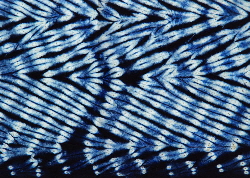Tie-Dye and Other Bound Resists
 Tie-dyeing or bound resist is a creative way of adding exciting colour patterns to fabric, scarves and T-shirts. The ties prevent the dye from reaching selected areas of the fabric. The places that the dye cannot reach remain white (or a pale colour) in contrast with the dyed areas. Tying the fabric also compresses it, allowing you to dye a longer length of fabric in one dye pot. Tie-dyeing or bound resist is a creative way of adding exciting colour patterns to fabric, scarves and T-shirts. The ties prevent the dye from reaching selected areas of the fabric. The places that the dye cannot reach remain white (or a pale colour) in contrast with the dyed areas. Tying the fabric also compresses it, allowing you to dye a longer length of fabric in one dye pot.
You can choose to just tie your fabric or you can fold the fabric and then tie it. You can also place small items such as pebbles on the cloth and bind the cloth around the pebbles. Another possibility is to stitch the resist with thread. Chance and accident give this dyeing technique a magical appeal. It is exciting to know that you are not in full control and that the final results may bring surprises.
Tie-dye is used in many countries: it is known as shibori in Japan, ‘adire oniko’ in Nigeria and ‘bandhani’ in India. This is an old technique, shibori for example dates back to the 6th century, and ‘adire oniko’ dates to at least the 11th century.
1. Choose your materials
a) Fabric for tie dyeing
b) Natural dyes for tie dyeing (opens a new page)
c) Choice of threads for tie dye (opens a new page)
d) Tie dye tips (opens a new page)
2. Shibori patterns (opens a new page)
a) Scrunching or marbling (opens a new page)
b) Tie-dye patterns (coming soon)
1. Choose your materials
First you need to choose your fabric, dye and threads. Below you will find guidance on types of fabric to use for tie dye with natural dyes, choice of natural dyes and what makes a good tie for tie dye.
a) Fabric for tie dyeing
You will achieve better results with a fabric that absorbs dye quickly, such as silk. However, cotton is commonly used for tie-dye, particularly with indigo. It is a good idea to experiment with lightweight cotton fabrics before moving onto silk and other more expensive fabrics. And before embarking on a larger project, it would be wise to try a sample with your chosen fabric to see how well it takes the dye and how clear the pattern is.
i) Cotton fabrics
Remember that you will need to scour your cotton fabric before you tie dye. Some fabric shops sell cottons that are ‘Prepared for Dyeing’ (PFD), they still need scouring, but not as much as fabrics that are not PFD.
- If you want well defined lines choose crisp cottons such as poplin. You will get more blurry lines on loosely woven cottons.
- You can make smaller knots on finer cloths, such as cotton voile or lawn, and therefore achieve more spectacular results.
- Patchwork shops often sell fabric for dyeing, dyers muslin, for example, produces good results. It is thicker than you would expect for muslin and very similar to calico.
- The type of weave will also affect the result; dense weaves with a high thread count such as percale are not as suitable for tie dye as it is not easy to make a good tie and the dye has difficulty in penetrating the fabric.
ii) Silk
Silk takes dye really well and it also absorbs colour quickly, two properties that make silk ideal to use with shibori. You will also get darker colours on silk than on cotton.
- Habotai 8 produces good results for scarves.
- Habotai 10 is suitable for making clothes.
- Pongee 5 is finer and more transparent than Habotai, making it more difficult to see the patterns.
- Dupion silk does not allow great definition, but the slubs in the silk can lead to unusual results.
iii) Felt
Of course, you don’t need to restrict yourself to fabric, thin handmade felt, thin pre-felts or nuno felt are great for shibori too.
Now Go to:
b) Natural dyes for tie dyeing (opens a new page)
c) Choice of threads for tie dye (opens a new page)
d) Tie dye tips (opens a new page)
Top of page
|